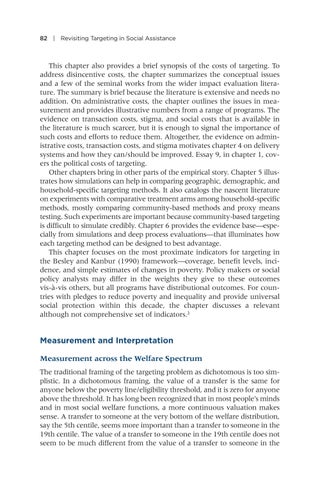82 | Revisiting Targeting in Social Assistance
This chapter also provides a brief synopsis of the costs of targeting. To address disincentive costs, the chapter summarizes the conceptual issues and a few of the seminal works from the wider impact evaluation literature. The summary is brief because the literature is extensive and needs no addition. On administrative costs, the chapter outlines the issues in measurement and provides illustrative numbers from a range of programs. The evidence on transaction costs, stigma, and social costs that is available in the literature is much scarcer, but it is enough to signal the importance of such costs and efforts to reduce them. Altogether, the evidence on administrative costs, transaction costs, and stigma motivates chapter 4 on delivery systems and how they can/should be improved. Essay 9, in chapter 1, covers the political costs of targeting. Other chapters bring in other parts of the empirical story. Chapter 5 illustrates how simulations can help in comparing geographic, demographic, and household-specific targeting methods. It also catalogs the nascent literature on experiments with comparative treatment arms among household-specific methods, mostly comparing community-based methods and proxy means testing. Such experiments are important because community-based targeting is difficult to simulate credibly. Chapter 6 provides the evidence base—especially from simulations and deep process evaluations—that illuminates how each targeting method can be designed to best advantage. This chapter focuses on the most proximate indicators for targeting in the Besley and Kanbur (1990) framework—coverage, benefit levels, incidence, and simple estimates of changes in poverty. Policy makers or social policy analysts may differ in the weights they give to these outcomes vis-à-vis others, but all programs have distributional outcomes. For countries with pledges to reduce poverty and inequality and provide universal social protection within this decade, the chapter discusses a relevant although not comprehensive set of indicators.3
Measurement and Interpretation Measurement across the Welfare Spectrum The traditional framing of the targeting problem as dichotomous is too simplistic. In a dichotomous framing, the value of a transfer is the same for anyone below the poverty line/eligibility threshold, and it is zero for anyone above the threshold. It has long been recognized that in most people’s minds and in most social welfare functions, a more continuous valuation makes sense. A transfer to someone at the very bottom of the welfare distribution, say the 5th centile, seems more important than a transfer to someone in the 19th centile. The value of a transfer to someone in the 19th centile does not seem to be much different from the value of a transfer to someone in the


